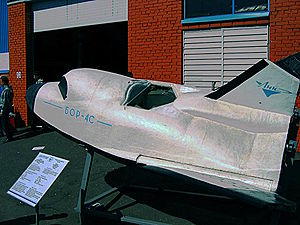
BOR-4
Encyclopedia

Spaceplane
A spaceplane is a vehicle that operates as an aircraft in Earth's atmosphere, as well as a spacecraft when it is in space. It combines features of an aircraft and a spacecraft, which can be thought of as an aircraft that can endure and maneuver in the vacuum of space or likewise a spacecraft that...
. An unmanned, subscale craft, its purpose was to test the heatshield tiles and reinforced carbon-carbon for the Buran space shuttle, then under development. BOR was the Russian acronym for Unpiloted Orbital Rocketplane.
Several of them were built and flown between 1982 and 1984 from the Kapustin Yar
Kapustin Yar
Kapustin Yar is a Russian rocket launch and development site in Astrakhan Oblast, between Volgograd and Astrakhan. Known today as Znamensk , it was established 13 May 1946 and in the beginning used technology, material, and scientific support from defeated Germany...
launch site at speeds of up to Mach 25. After reentry, they were designed to parachute to an ocean splashdown for recovery by the Soviet Navy
Soviet Navy
The Soviet Navy was the naval arm of the Soviet Armed Forces. Often referred to as the Red Fleet, the Soviet Navy would have played an instrumental role in a Warsaw Pact war with NATO, where it would have attempted to prevent naval convoys from bringing reinforcements across the Atlantic Ocean...
. The testing was nearly identical to that carried out by the US Air Force ASSET program
ASSET (spaceplane)
-Winged Gemini:In the mid-1960s, McDonnell proposed a variant of the Gemini capsule which retained the original spacecraft's internal subsystems and crew compartment, but dispensed with the tail-first ballistic reentry, parachute recovery and water landing....
in the 1960s, which tested the heatshield design for the X-20 Dyna-Soar
X-20 Dyna-Soar
The X-20 Dyna-Soar was a United States Air Force program to develop a spaceplane that could be used for a variety of military missions, including reconnaissance, bombing, space rescue, satellite maintenance, and sabotage of enemy satellites...
. On June 3, 1982 a Royal Australian Air Force
Royal Australian Air Force
The Royal Australian Air Force is the air force branch of the Australian Defence Force. The RAAF was formed in March 1921. It continues the traditions of the Australian Flying Corps , which was formed on 22 October 1912. The RAAF has taken part in many of the 20th century's major conflicts...
P-3 Orion
P-3 Orion
The Lockheed P-3 Orion is a four-engine turboprop anti-submarine and maritime surveillance aircraft developed for the United States Navy and introduced in the 1960s. Lockheed based it on the L-188 Electra commercial airliner. The aircraft is easily recognizable by its distinctive tail stinger or...
reconnaissance aircraft captured the first Western images of the craft as it was recovered by a Soviet ship near the Cocos Islands.
The wings were now fixed at the 60-degree up position and functioned solely as vertical stabilizers.
Flights
- 1982/06/04 - COSMOS 1374 - suborbital - splashed down into the Indian Ocean about 900 km to the west of Australia
- 1983/03/16 - COSMOS 1445 - orbital - splashed down into the Indian Ocean about 900 km to the west of Australia
- 1983/12/27 - COSMOS 1517 - orbital - splashed down into the Black Sea to the west of the Crimea peninsula
- 1984/12/19 - COSMOS 1614 - orbital - splashed down into the Black Sea to the west of the Crimea peninsula

